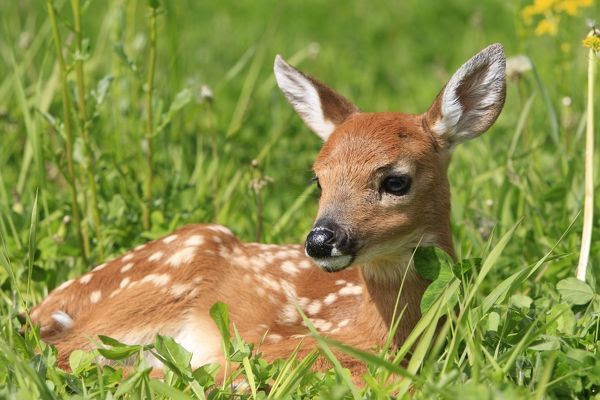“Oh Deer…”

WAT-16853 White-tailed Deer – fawn Minnesota – United States Odocoileus virginianus M. Watson Please note that prints are for personal display purposes only and may not be reproduced in any way.
February 3, 2022
In July, the United States Department of Agriculture reported that antibodies to the Coronavirus had been detected in the white-tailed deer population in Illinois, Michigan, New York, and Pennsylvania. The agency also reported in August that its sampling found an actual virus in deer in Ohio. This sounds alarming. Covid in deer? Well unfortunately, it is possible. This all started when infected workers were most likely introduced to infection on mink farms. Farmed mink are skinned for their fur; more than 85% of pelts used in the world’s fur trade come from mink. When infected workers came into contact with the mink, the virus then began to spread among the mink. Once the virus is introduced on a farm, it can spread between mink, and to other animals on the farm such as cats and dogs, then to humans. This is how pandemics often start; when a virus spreads from animals to humans. It’s especially damaging when it spreads to agricultural animals we use as food such as cows, chickens, and pigs.
Recently, Penn State University researchers published a study showing that a growing number of deer in Iowa had tested positive, reflecting most likely human-to-deer and deer-to-deer transmission. “Humans are the presumptive spreaders of infection among deer,” says Angela Bosco-Lauth, PhD, assistant professor of biomedical sciences at Colorado State University. Deer infecting humans is less likely, she says. “The likelihood of a human contracting it from a deer they’ve just shot is pretty minimal”.
It cannot be entirely ruled out, however. Bosco-Lauthstates states,“With this coronavirus, what we’re seeing is fairly unprecedented in history, noting the massive number of infections worldwide”. The virus also can spread to exotic zoo animals such as the three snow leopards at the Lincoln Children’s Zoo who recently died from COVID-19 complications. Two of the zoo’s tigers also caught the virus in October but have since recovered. This is something that should not be taken lightly; these big cats along with many other critically endangered animals such as the pair of red pandas from the Chiang Mai Zoo have died because of COVID-19.
So what does this mean for us? The CDC says humans can and do spread COVID-19 to animals, including domestic pets, farmed animals such as mink, and zoo animals. However, the National Academy of Sciences emphasizes that there’s still no evidence COVID-19 can spread from animals to humans, with the exception of farmed mink. COVID-19 is not transmitted through blood — it is a respiratory disease. There’s no evidence anyone could get sick from eating deer meat, but some states are telling hunters to take additional precautions when field-dressing white-tailed deer. Wisconsin has suggested hunters wear masks and also advises hunters to limit handling or cutting of the lungs, throat, and mouth/nasal cavity.
What should we learn from this information? If we can all put in the extra effort to be more careful and respectful of the animals we interact with, then we can surely prevent the spread of Covid from humans to animals.











